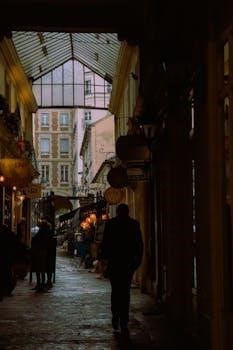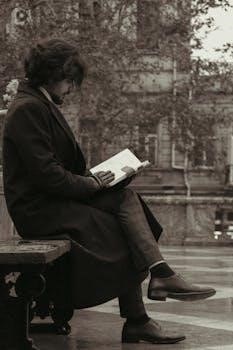Overview of “The Devil in the White City”
Erik Larson’s gripping non-fiction novel‚ “The Devil in the White City‚” masterfully intertwines the grandeur of the 1893 Chicago World’s Fair with the sinister deeds of serial killer H.H. Holmes‚ creating a chilling narrative.
The Book’s Central Theme
The central theme of “The Devil in the White City” revolves around the stark juxtaposition of two seemingly disparate narratives⁚ the magnificent creation of the 1893 Chicago World’s Fair and the horrific crimes of H.H. Holmes. Larson explores the duality of human nature‚ showcasing the incredible heights of innovation and achievement alongside the depths of depravity and evil. The book delves into the era’s optimism and progress‚ while simultaneously revealing the darkness that lurked beneath the surface of the “White City.” It highlights the contrast between the public face of progress and the hidden realities of crime and corruption. The book also touches upon the themes of ambition‚ deception‚ and the allure of the extraordinary‚ all set against the backdrop of a pivotal moment in American history. This interplay between light and shadow‚ beauty and horror‚ forms the core of the book’s narrative‚ making it a compelling study of the human condition.
Juxtaposition of the 1893 World’s Fair and H;H. Holmes
The narrative brilliance of “The Devil in the White City” lies in its masterful juxtaposition of the 1893 World’s Fair and the activities of H.H. Holmes. The fair‚ a symbol of American ingenuity and progress‚ is contrasted sharply with Holmes’s sinister deeds‚ which take place in the same city during the same time period. This contrast heightens the sense of unease and provides a compelling look at the era. While the city celebrates the marvels of the fair‚ Holmes lures his victims into his “murder castle‚” a stark reminder of the darkness hidden beneath the veneer of progress. This juxtaposition creates a powerful tension that propels the narrative forward‚ forcing readers to confront the dual nature of human experience⁚ the capacity for both breathtaking creation and unspeakable evil. The fair’s grandeur serves as a chilling backdrop to Holmes’s horrific crimes‚ making the story all the more haunting.

Availability of “Devil in the White City” in PDF Format
Numerous online platforms offer “The Devil in the White City” in PDF format‚ allowing readers to access the full text digitally. These resources often include options for free downloads and complete versions.
Free PDF Downloads
The search for free PDF versions of “The Devil in the White City” often leads to various websites offering downloadable files. These sources may include online libraries‚ educational platforms‚ and file-sharing sites. However‚ users should exercise caution when downloading from unfamiliar sources to avoid potential malware or copyright infringement issues. Some sites may offer partial previews or summaries‚ while others promise full‚ free PDF copies. It’s essential to verify the legitimacy and safety of the site before proceeding with any downloads. The availability of free PDF versions can fluctuate‚ and it’s advisable to explore multiple sources if initial searches are unsuccessful. While some sites may offer direct downloads‚ others might require registration or have specific download limits. Always check the file size and format before downloading to ensure it matches your needs. Additionally‚ keep in mind that the quality of free PDF files can vary depending on the source‚ with some being clearer than others. Always prioritize secure and reputable platforms to avoid any security risks.
Where to Find Full PDF Versions
Locating full PDF versions of “The Devil in the White City” can be achieved through several avenues. Reputable online book retailers often provide digital copies for purchase‚ which can then be downloaded as PDFs. Some public libraries may also offer access to digital versions of the book through their online platforms‚ often requiring a library card for access. Furthermore‚ certain academic databases and educational institutions may have licensed copies available for students and faculty. It’s important to note that obtaining a legitimate PDF version often involves a purchase or access through a subscription service. Be wary of sites offering free downloads that seem too good to be true‚ as these may be illegal or contain viruses. Always prioritize legal and reliable platforms to ensure a safe download and to support the authors and publishers. Check for any reviews or ratings associated with download sources before proceeding. The availability may vary between regions‚ so it’s always a good idea to check multiple sources for the best option.

Key Elements of the Book’s Narrative
The narrative centers on two parallel storylines⁚ Daniel Burnham’s ambitious construction of the 1893 World’s Fair and the horrifying crimes of H.H. Holmes‚ a serial killer‚ operating in Chicago at the same time.
Daniel Burnham’s Role in the World’s Fair
Daniel Burnham‚ a prominent architect‚ is portrayed as the driving force behind the 1893 World’s Fair in Chicago. The book details his immense challenges in designing and constructing the fairgrounds‚ which faced numerous obstacles‚ including tight deadlines‚ logistical nightmares‚ and financial constraints. Burnham’s leadership and determination are central to the narrative‚ showcasing his ability to overcome seemingly insurmountable problems. The text highlights his collaborative spirit‚ his strategic planning‚ and his unwavering vision‚ which transformed a swampy area into the magnificent “White City.” The narrative explores his interactions with other key figures‚ including his partner John Root and the various artists and engineers involved in the project. Furthermore‚ the book examines his personal struggles‚ his ambition‚ and his commitment to making the fair a success despite the odds. Burnham’s character serves as a stark contrast to the dark and sinister figure of H.H. Holmes‚ creating a compelling juxtaposition of light and darkness. His dedication to creating this landmark of American history is a recurring theme throughout the book‚ emphasizing his role as a visionary and a leader.
H.H. Holmes’s Murders
H.H. Holmes‚ a cunning and charismatic figure‚ is portrayed as a serial killer who used the bustling atmosphere of the 1893 Chicago World’s Fair to his advantage. The book delves into his meticulously constructed “Murder Castle‚” a building designed with hidden rooms‚ secret passages‚ and torture devices‚ all specifically for luring and killing his victims. The text examines the methods he employed to attract unsuspecting individuals‚ often exploiting their vulnerabilities and naivety. His manipulative nature and his ability to blend into polite society are highlighted‚ emphasizing the chilling contrast between his public persona and his private acts of depravity. The narrative explores his various schemes‚ including fraudulent businesses and insurance scams‚ which he used to fund his murderous activities. Moreover‚ the book details the investigation into his crimes‚ the challenges faced by law enforcement‚ and the eventual discovery of his horrific acts. The stories of his victims‚ while not always explicitly detailed‚ underscore the grim reality of his crimes and the impact on the lives he destroyed. The book portrays Holmes as a master of deception‚ capable of maintaining a facade of normalcy while committing unspeakable atrocities.

Critical Reception and Analysis
The book has garnered significant praise for its engaging narrative style‚ seamlessly blending historical fact with true crime elements. Critics have lauded Larson’s ability to bring both the fair and Holmes to life.
The Book’s Literary Merit
Erik Larson’s “The Devil in the White City” showcases exceptional literary merit through its masterful blend of historical research and narrative storytelling. The book’s structure is meticulously crafted‚ alternating between the progress of the 1893 World’s Fair and the sinister activities of H.H. Holmes‚ creating a compelling juxtaposition that heightens the tension and intrigue. Larson’s prose is both elegant and accessible‚ allowing readers to become fully immersed in the late 19th-century setting and the lives of its characters. The book’s strength lies in its ability to transform well-documented historical events into a suspenseful and engaging narrative‚ making it a page-turner despite its non-fiction genre. Furthermore‚ Larson’s attention to detail‚ evident in his meticulous research and vivid descriptions‚ adds depth and authenticity to the story. The seamless integration of factual accounts with a captivating plot makes the book a standout piece of historical literature‚ demonstrating its significant literary value.
Historical Accuracy and Narrative Style
“The Devil in the White City” is renowned for its rigorous commitment to historical accuracy‚ meticulously researched from primary sources‚ including letters‚ diaries‚ and newspaper accounts of the period. Erik Larson’s narrative style is a blend of factual reporting and engaging storytelling‚ creating a captivating reading experience that does not sacrifice historical integrity for entertainment. The book effectively interweaves the narratives of Daniel Burnham and H.H. Holmes‚ presenting their contrasting worlds with equal depth and detail. Larson employs a narrative technique that allows readers to feel the suspense and tension of the era‚ bringing the historical context to life. While the book is based on true events‚ Larson’s writing style is so vivid that the reader is easily drawn into the narrative‚ making it feel like a suspenseful fiction‚ and it is this combination of strict factual basis and compelling narrative that gives the book its unique appeal.

Additional Resources
Readers interested in exploring further can find related maps of the 1893 World’s Fair and other works by Erik Larson. These resources enhance the understanding of the book’s historical context.
Related Maps and Visual Aids
To fully appreciate the scope of the 1893 Chicago World’s Fair‚ exploring related maps and visual aids is essential. These resources offer a tangible connection to the book’s setting‚ allowing readers to visualize the layout of the fairgrounds and the city itself. Maps from the era‚ such as those from the Rascher Publishing Company‚ provide detailed views of the fair’s structures and pathways‚ enabling a deeper understanding of the environment where both the grand celebrations and the sinister events unfolded. These visual aids‚ often available through historical societies like the Chicago Historical Society‚ offer a spatial perspective that complements the written narrative. Examining these maps allows readers to trace the movements of characters within the book‚ enhancing their comprehension of the geographical context. The juxtaposition of the fair’s grandeur and the dark secrets hidden within the city becomes more palpable through these visual representations‚ providing a richer reading experience. By utilizing these historical maps‚ one can gain a greater sense of the scale of both the fair and the dark deeds that took place.
Other Books by Erik Larson
Erik Larson‚ the author of “The Devil in the White City‚” is renowned for his captivating narrative style that blends historical events with compelling storytelling. Readers who enjoyed “The Devil in the White City” might also be drawn to his other works‚ which explore various periods and subjects with similar depth and engagement. Some of his notable titles include “Dead Wake‚” focusing on the sinking of the Lusitania‚ and “In the Garden of Beasts‚” which examines the American ambassador’s family in Nazi Germany. Each of Larson’s books demonstrates his ability to weave together meticulous research and gripping prose‚ creating immersive historical narratives. His work often highlights both the grand events of history and the personal stories of individuals caught up in them. These books‚ similar to “The Devil in the White City‚” are meticulously researched and provide a sense of historical authenticity‚ making them ideal for those seeking more of Larson’s unique blend of non-fiction and narrative. Exploring his broader bibliography reveals his consistent ability to bring the past to life.
